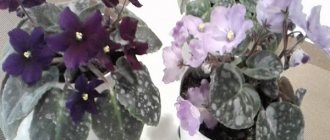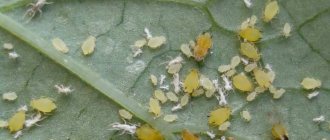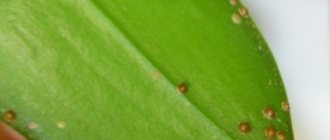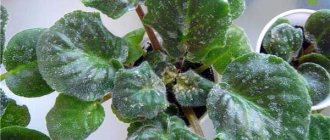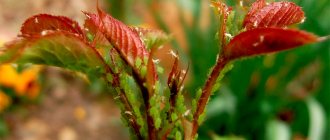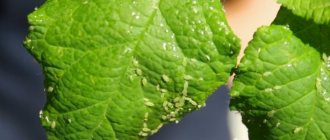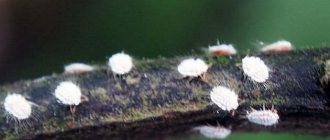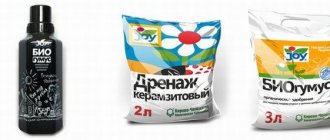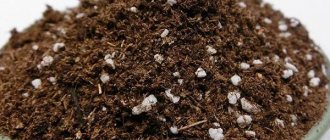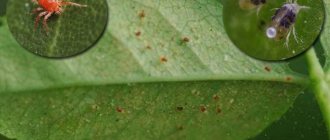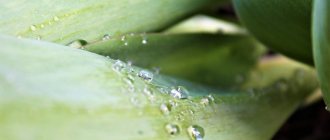Methods of combating a disease such as powdery mildew include a whole range of measures. This also prevents the occurrence of disease at the earliest stages of plant growth. Treatment with chemicals.
Dear readers! For you, we have created communities on social networks in which useful articles and interesting ideas are published several times a day! Subscribe and receive useful content in a convenient format!
In this article we will talk about the best ways to get rid of the disease. You will learn why plants suffer from powdery mildew and how to prevent its occurrence in your garden.
What is powdery mildew, dossier
First of all, let's talk about what kind of disease this is, “powdery mildew”.
So, powdery mildew is nothing more than a mycelium of a pathogenic fungus. Microorganisms penetrate the plant tissue and begin to feed on its sap.
As a result, the leaf blades atrophy, become yellow and lethargic.
With multiple magnification, you can notice that the leaves of the plants seem to be gnawed by a fungus. Such damage leads to disruption of photosynthesis processes.
All this leads to the death of living plant tissues and their gradual withering and death.
IMPORTANT! Sick fruits should not be eaten under any circumstances, as poisoning is possible.
How to recognize powdery mildew, photo, how it begins
Manifestation on tomatoes
The disease can manifest itself on completely different cultivated plants. Let's talk about how to recognize powdery mildew in the early stages.
Manifestation on cucumbers
Powdery mildew appears as a whitish “fluffy” coating on leaves, fruits and stems.
Disease on currants
The disease begins as the appearance of small white spots. Soon they grow, covering the entire leaf blade or fruit.
Disease on gooseberries
Liquid is gradually released and remains on the infected part of the plant.
Disease on roses
Many crops are susceptible to the disease. For example, gooseberries, currants, acacia, hawthorn, pear, oak, strawberries, roses, peaches, tomatoes, cucumbers, indoor flowers.
Infected violet
The disease begins to spread from the lower part of the plant, since the fungal spores are mainly found in the soil.
Sick apple tree
Causes of infection
Powdery mildew or mildew on indoor plants often appears in rooms with stagnant air. If owners rarely ventilate a room in which there are many plants, then the risk of developing fungal diseases on the leaves is increased. The accumulation of moisture in the room negatively affects the condition of the specimens from the green corner.
READ ALSO: Sucking whitefly parasite on indoor plants: how to fight at home using chemicals and folk remedies
Powdery mildew gets to indoor flowers in several ways:
- spores are airborne;
- housewives collect soil for a new flower from a nearby flowerbed or from a summer cottage;
- from a flower shop when purchasing plants for a green corner: spores are in contaminated soil;
- An amateur gardener touches healthy plants after caring for diseased flowers. Microscopic spores remain on hands or gloves and easily fall on buds and green mass. You should always wash your hands or remove protective gloves after spraying, collecting fallen leaves, loosening the soil, or other actions with specimens contaminated with laundry.
The main reasons for the development of powdery mildew are:
- high humidity in the home (more than 70%);
- room temperature +25 degrees and above in combination with excess moisture in the apartment for a long period;
- drops often remain on the leaf blades and in the root rosettes after spraying, creating favorable conditions for the growth of mycelium;
- improper watering: an amateur gardener adds water to the flowerpot even when the substrate moisture is good, or intensively waters the plant without loosening the outer layer, which has turned into a dried crust;
- weak turgor of stems and leaves, wilting of green mass due to diseases;
- excessive application of nitrogenous fertilizers in combination with insufficient Ca content in the substrate;
- the indoor flower is weakened by the attack of pests: thrips, mealybugs, spider mites, aphids, scale insects;
- excessive watering combined with high air humidity.
READ ALSO: How to fight spider mites on indoor plants: effective chemicals and folk remedies
Where does powdery mildew come from?
The next question that needs to be sorted out is where the disease comes from, what pathogen is its causative agent.
Powdery mildew is caused by the pathogenic fungus Erysiphales. It is classified as powdery mildew. This name, as you understand, was given for its characteristic appearance.
The plants seemed to be covered with white flour dew.
Powdery mildew is often found in the soil, but for the most part it is dormant. They show their activity only in the event of favorable environmental conditions.
- Low temperature with high humidity;
- Increased nitrogen content in the soil;
- Density of plantings of cultivated plants;
- Incorrect watering regime;
- External infection (during transplantation, with water, from neighboring plants).
Features of the disease
Fungal disease can be caused by different types of microscopic pathogens. The main signs are drops of liquid that appear after the spores mature and a white coating. This is where the name of the disease comes from. To combat it you need to know the following.
- Nature of the defeat. The leaves, buds, and stems of the plant become covered with white spots that can be erased. Over time, their size increases. They become brownish or gray in color. If there are large affected areas, the foliage begins to dry out. Next, the mycelium becomes dense and acquires the structure of felt or film. The main symptoms of the disease are stunted growth of indoor crops, deformation, and falling leaves. The buds cannot open and flowering stops. The plant loses its decorative properties.
- Pathogen. Powdery mildew mushrooms belong to a large category, which is combined into genera, dozens of species. The pathogen persists in the remains of the plant. Infection occurs through fungal spores, which are carried through the air and come in with water during irrigation. The disease is transmitted through contact of a healthy plant with a diseased one.
- Conditions for the development of the disease. It appears in conditions of high air humidity (60-80%) and temperatures above 20-25°C. It develops if the soil contains a high content of nitrogen and a low content of calcium. Those indoor crops that do not have enough space for normal development suffer. Non-compliance with the watering regime also contributes to the appearance of the disease.
- Time of appearance. The disease spreads in early summer. After winter sleep, the watering regime and temperature conditions change. Improper care leads to infection.
Sometimes this disease is confused with peronosporosis - downy mildew. Diseases differ from each other in the nature of the lesion. With downy mildew, oily yellow-green spots appear on plants. They have the shape of an angle or a circle, with limited veins. Over time, a coating appears, but not white, but gray-violet. The disease is spread by insect pests.
What chemicals help against powdery mildew, table
The fastest and most effective way to get rid of powdery mildew and prevent its development on shrubs and trees is to use chemicals.
There are now many different fungicides on the market that help with powdery mildew.
In the following table we will look at the most popular and effective of them.
Table of fungicides for powdery mildew
| Fungicide | Directions for use/dosage |
| Fundazol | Dissolve 10 grams of powder in a bucket of water. Carry out processing during the growing season. |
| Topaz | Dissolve 2-4 ml in 10 liters of water. Carry out up to 4 treatments every 2 weeks. Consumption – a bucket per hundred square meters. |
| Acrobat MC | 20 grams of powder per 5 liters of water. This amount is enough for 1 hundred square meters of crops |
| Previkur | Dissolve 25 ml in 5 liters of water. The product can be used for leaf treatment, as well as for watering plants at the root to suppress microflora in the soil |
| Score | Dissolve 2 to 5 ml in a bucket of water. Spray when signs of disease appear every 2 weeks. The consumption rate of the working solution is a bucket per hundred square meters. |
| Vitaros | Can be used for processing planting material and spraying during the growing season. To prepare a working solution you need 2 ml per 1 liter of water. |
| Copper sulfate | 100 grams of the drug per 10 liters of water. Treat until the buds open. |
| inkstone | 300 g of the drug per 10 liters of water. Treat until the buds open. |
| Topsin | Used on an industrial scale. Treatment should be carried out during the growing season |
| Bordeaux mixture | Treat before flowering begins. |
IMPORTANT! When processing, do not skimp on the working solution. Experienced gardeners say that the plant should flow. If possible, directly dip diseased plants into the fungicide solution.
Also, do not forget to treat the walls of the greenhouse, flowerpots, pallets, etc.
What biological products can be used
Modern agricultural industry offers summer residents preparations based on microorganisms. This is also a way to defeat powdery mildew on plants.
Among the most effective are Alirin-B, Pseudobacterin-2, Gamair and Planriz. But Fitosporin helps little in the fight against an already developed disease. But the drug can be used for preventive purposes.
Biological products are good because they are ordinary microorganisms that suppress the development of pathogenic microflora.
They are harmless to humans and can be used during the flowering period.
The disadvantage of such products is that they only work in warm weather. That is, they cannot be used in early spring and late autumn.
Why is it dangerous?
In warm, humid weather, the fungus can destroy the crop within a week. Microorganisms quickly mutate and adapt to unfavorable conditions and fungicides. Spores are easily transported by wind currents from an affected specimen to a healthy one, dormant in the ground in plant debris. One bush will cause the death of the entire collection.
Powdery mildew on house flowers impairs the development of buds. Sick plants look unhealthy and growth stops. The active growth of mycelium destroys greenery and young shoots. Diseased specimens do not bloom, often shed their plates and dry out the lashes.
Traditional methods of combating powdery mildew
In addition to chemicals, you can also use traditional methods of combating the disease.
ON A NOTE. We must be aware that folk recipes are much less effective than chemicals. Therefore, it is better to use them as prophylactic drugs.
Soap and soda solution
You will need 50 grams of soda ash and a tablespoon of liquid soap. All this is stirred in a bucket of hot water. The solution can be used only after it has cooled to an acceptable temperature.
Treatment with this composition is carried out three times over 3 weeks.
Baking soda and soap
We take the same amount of water as in the previous recipe. Add 2 heaped tablespoons of baking soda and 2 tablespoons of liquid soap. Mix everything thoroughly until smooth and process the plants.
Number of treatments – no more than 3, interval – 1 week.
BY THE WAY! The soap in such recipes ensures that the working solution sticks to the leaves and stems of the affected plants.
Potassium permangantsovka
Previously, potassium permanganate was considered an effective remedy for powdery mildew. You need 2.5 grams of this drug per bucket of water. In 2 weeks you need to carry out 3 treatments of diseased plants.
Serum
Milk fungi suppress pathogens with their activity. That is why kefir or whey is often used to combat fungal diseases. To get rid of powdery mildew, mix water with whey (1 part whey to 10 parts water). Spraying is carried out every three days. There should be at least 3 treatments in total.
Horsetail decoction
You will need 300 grams of horsetail and 3 liters of warm water. Fill the grass with water and leave to infuse for 24 hours.
Next, simmer over low heat for a couple of hours. You get a concentrate that must be diluted with clean water in a ratio of 1 to 5.
Over 3 weeks, at least 4 treatments of diseased crops are carried out.
Soap solution based on copper sulfate
Take 5 grams of the drug and dissolve it in a glass of water. At the same time, dissolve half a bar of soap in 5 liters of water.
Next, combine the solutions. Treatment is carried out every week. Only 3 sprays.
Mustard infusion
This drug can not only be used to treat the leaves, but also water the soil under the plants, suppressing pathogenic microorganisms.
The product is easy to prepare: 2 tablespoons of mustard powder are dissolved in a ten-liter bucket of water.
Garlic infusion
For a bucket of water you need 250 grams of finely chopped garlic. The mixture is kept for 1 day, after which the diseased crops are treated generously.
Iodine
A ten-liter bucket of water requires 10 drops (10 ml) of iodine. For roses, the concentration can be increased 3 times (up to 30 ml of iodine).
Ash infusion
Prepare a concentrate from half a glass of ash and a liter of boiling water. Leave for 2 days. Add liquid soap for adhesion.
Carry out no more than 2 treatments within 2 weeks, after which use another product.
Mullein infusion
Prepare mullein. Mix with clean water 1 to 10. Spray after sunset.
Onion peel infusion
Fill the husk with water. Leave for a day. Spray and water the soil under the plants.
Fighting the disease using agrotechnical methods
Treatment with different compounds is not the only way to cure the disease. Some agricultural practices also help to cope with it.
So, the most important thing in the fight against powdery mildew is proper watering. You only need to pour water when the top layer of soil dries out. It is also worth mentioning here about mandatory loosening and mulching.
Loosening will provide access to air and will not allow liquid to stagnate at the roots, and mulching will prevent excessively rapid evaporation of moisture.
As soon as you begin to fight the disease, you must immediately exclude any foliar feeding.
If the disease appears on flowers, take the pots to a sunny place. The sun is your assistant in the fight against powdery mildew.
Treatment of flowers
Take preventive measures to prevent infection of indoor and outdoor flowering plants:
- regularly monitor plantings;
- follow planting recommendations (choose the correct distance between bushes, choose a well-lit place, plant in a place protected from drafts);
- timely removal of weeds;
- avoid nitrogen fertilizers, choose organic fertilizers;
- for preventive purposes, sprinkle with special preparations;
- in the fall, remove dried plant remains, bury the root zone deeply;
- choose varieties that are resistant to ash blight.
Fungicides are used to control white spots on houseplants. Sprinkle this product on both the soil and the walls of the pot. If the flower is heavily infected, remove the top layer of the substrate affected by the mycelium and replace it with fresh, disinfected soil. The most effective way is to pour medicinal liquid into the pool and dip the greens into it, watering the soil generously.
Some tips for preventing downy mildew:
- Watering is allowed provided that all layers of the substrate are completely dry;
- Alternative crops;
- Plant varieties resistant to fungi;
- Fertilization with potash-phosphorus fertilizer increases resistance to spores;
- Spring pruning of bushes and trees;
- After the leaves have fallen, apply a preventative fungicide.
Measures to prevent the appearance
In order not to waste energy, time and money, it is much easier to prevent powdery mildew from appearing on your cultivated plants.
Let's consider preventive measures that will help protect plants from disease.
- Destruction of diseased parts of plants;
- Weeding;
- Compliance with crop rotation standards;
- Purchase of genetically resistant varieties and hybrids;
- Ensure normal air access to all parts of plants;
- Disinfect working tools;
- Observe the regimes of watering and fertilizing plants;
- Carry out preventive treatment with fungicides in early spring and late autumn.
Common mistakes
Now let's figure out what the most common mistakes are in the fight against powdery mildew.
- No preventive measures are taken. It is much easier to prevent a disease than to deal with its consequences later.
- Removed diseased parts of plants are not destroyed. It is very important to burn diseased plants to destroy the fungus. If this is not done, the pathogen will again move to healthy plants.
- A single or light treatment is carried out. The key to cure is copious spraying with fungicides. Most often, the treatment needs to be repeated 1-2 times to achieve a sustainable effect.
- Diseased fruits are eaten. This may cause poisoning, diarrhea and nausea.
Causes provoking the appearance and development of the disease
Spores of powdery mildew fungi live in the soil and wait for the most favorable moment to settle on living vegetation and begin to reproduce. They show their activity under certain conditions:
- violation of the watering regime (excessive or frequent wetting, especially in cool weather);
- densely planted or improperly formed bushes, due to which the sun does not penetrate inside and there is no ventilation;
- incorrect quantitative ratio of nitrogen and phosphorus-potassium fertilizers, when excess nitrogen causes rapid growth of foliage (it becomes succulent, soft and susceptible to disease);
- optimal temperature and humidity conditions for the pathogen (humidity 80-90%, temperature 15-170 C).
To prevent powdery mildew from developing rapidly on roses, timely measures are taken to combat it, trying to avoid excessive humidity, and adjust the composition of nutrient mixtures.
It will be useful to read:
Black spot and methods of combating it Basic description of the disease Black spot is caused by the fungus Marssonina rosae, which, when it gets on plants…
Answers to frequently asked questions
And in conclusion, a small FAQ on the topic of today's article.
Which drug is most effective against powdery mildew?
Topaz has proven itself well.
What can be done to prevent plants from getting sick?
Carry out prevention and do not disdain agricultural practices. Be sure to disinfect the soil.
How many times should plants be sprayed?
Depends on the product you are using.
How to treat diseased fruits?
Either with means prepared according to folk recipes, or with biological products.
